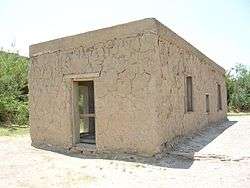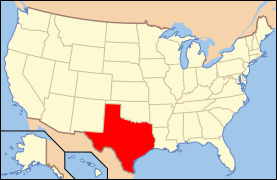Daniels Farm House
The Daniels Farm House represents one of the last vestiges of West Texas pioneer farming in Big Bend National Park, Texas. Most of the small-scale farms in the Big Bend area quickly fell into ruin after the park was established in 1944. Larger-scale ranch structures survived in greater numbers, but the small-scale irrigated bottomland farms have not. The farm is located next to the Rio Grande.
Daniels Farm House | |
 | |
 Daniels Farm House  Daniels Farm House | |
| Nearest city | Rio Grande Village, Texas |
|---|---|
| Coordinates | 29°11′8″N 102°58′18″W |
| Area | 0.2 acres (0.081 ha) |
| Built | 1918 |
| Built by | John O. Wedlin, John R. Daniels |
| NRHP reference No. | 89001627[1] |
| Added to NRHP | October 20, 1989 |
History
The original landowner was Jesus Estrada, who sold the land to John O. Wedlin, a Swedish immigrant. Wedlin, who had farmed wheat in Kansas, leveled the fields, installing a pump-powered irrigation system, establishing one of the first such farms in the area. Wedlin also built the house now known as the Daniels Farm House as a storage shed for farm equipment. Wedlin lived about a mile away, raising wheat for eight years. He sold the farm to cattleman Joe H. Graham of Del Rio, Texas in 1926. Graham, who owned the Lou Buttrill Ranch in the northern Big Bend, used the grain from the Daniels operation to feed his cattle, turning them out in the fields in winter. The Grahams expanded the operation, but sold the northern 200 acres (81 ha) of the property to John R. Daniels and Mary Coe Daniels of Presidio in 1937. The Daniels moved into the former storage shed, using it as their residence and adding a room to house a small store that catered to local residents in the Boquillas community. Daniels converted about 100 acres (40 ha) to cotton. When the park was established in 1944, the Daniels moved away.[2]
Description
The house is a two-room adobe building, about 44 feet (13 m) by 15 feet (4.6 m). The house was roofed with cane latillas over aspen log vigas in a style traditional to the area. Th house's surroundings retain traces of the irrigated farm environment and possess good historical integrity.[2]
A small portion of the Daniels Farm comprising the house and its immediate surroundings is incorporated in the National Register of Historic Places listing, established on October 20, 1989. Much of the immediate area has been incorporated into the National Park Service's Rio Grande Village, otherwise known as Boquillas.[1][2]
See also
References
- "National Register Information System". National Register of Historic Places. National Park Service. July 9, 2010.
- Gomez, Arthur R. (February 4, 1986). "National Register of Historic Places Inventory - Nomination Form: Daniels Farm House". National Park Service. Retrieved 31 October 2011.
| Wikimedia Commons has media related to Daniels Farm House. |

